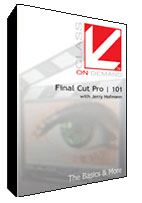

Tutorial Review - Final cut Pro February 24, 2003
Final Cut Pro 101; The Basics & More


Tutorial Review - Final cut Pro February 24, 2003
Final Cut Pro 101; The Basics & More
Required Hardware/Software:
CD-rom drive and VHS player for VHS version,
DVD player and CD-Rom for DVD version,
Final Cut Pro for both.
Purchase at Class On
Demand
Review by Tony Donaldson
For around $50, this has to be one of the least
expensive training videos on the market. Jerry
Hofmann teaches the basics of setting up
and editing in Final Cut Pro 3. "The Basics & More"
is a good title, and the material covers a two-camera shoot and
edit, and includes the source material on CD-Rom so you can edit
right along with him.
It's really basic, in that it covers topics for the first-time user, but there are a lot of useful tips buried within for more experienced users. Things like the easiest way to get 44khz audio from a CD in one step to 48 khz audio for FCP using Quicktime (Pro version, of course).
It's available on VHS or DVD, depending on your preference. Jerry is easy to listen to and informative, covering how to organize your media, reconnect it if needed, edit within the timeline, add titles, transitions, and basically everything you need to get started editing in FCP.
My one gripe, perhaps my only one, is that there aren't enough chapters. Makes it VERY hard to go back to where you left off or to find a really specific technique if needed without having to hold the ffwd or rwd buttons for a while.
The first chapter, Introduction & Equipment Overview, is really basic and walks you through the capabilities you probably already know.
The second chapter, Setting Up Preferences, takes you through the basics of how to set up FCP for most of the projects that most people do. Doesn't explain any of it in depth, but covers the majority of what people do with FCP.
Third chapter, The Interface, is similar, explaining the interface and its basic elements. Goes into enough detail to get you quite familiar with the controls, etc. which is especially helpful if you're new to NLEs.
Then we got to the behemoth fourth chapter, Your First Edit. This is the one that would have been nice to have a few chapter marks to skip to. It does cover a two camera edit nicely, good emphasis on the types of edits you can do and how to do them, plenty of good keyboard shortcuts, editing with and without sound, and more. Much more. It covers a lot of ground and is definitely the meat of the program.
Jerry does a good job of getting you into frame-accurate cuts and gets you around some bad camera work and some of the normal problems editors encounter. He covers a lot with slipping and overwriting clips from both cameras, with insert shots and a dream sequence with some fancy transitions.
The Basic Audio Controls chapter is about two minutes long. It's one tip about keeping audio low, and doesn't really explain why, or how to edit both channels simultaneously, how to go a dB at a time, etc. There was more audio detail in the previous chapter. This section isn't a section, it's a brief tip. This one I was disappointed in, compared to the rest of the DVD.
The last chapter, Output to Tape, it also very basic, but does get the beginner set to at least be able to lay their completed project to tape in one of two ways. Again, not going into adding bars & tone, leader, or anything else, and not really telling why.
With the main part being fairly informative, and the whole video being an overview, it packs a lot in for about 50 bucks. This video is an easy way to get a feel for FCP if you've not used it before, and some useful tips even if you have. It's a great value for the money, and one would almost hope it may expand into a more in-depth series. But the bare basics to get you running is enough for many people, who can then explore deeper through the manual or the many books currently available.
I'd recommend this program to any beginning FCP user.
copyright©2003 Tony Donalson
About Tony Donaldson : Tony is a sports
photographer (still photography, mostly extreme sports) with
clients including Sports Illustrated for Kids, ESPN the Magazine,
Millimeter, Video Systems, Panasonic, Lee Jeans and many more.
He also shoots, edits and produces video projects from commercials
to short films (Odessa or Bust, The Cypher) to the Redline Bicycles
Team video to a new video-based photography training series and
a television pilot. He lives and works in the Los Angeles area
and spends way too much time online learning all of Ken Stone's
secrets .
http://www.tdphoto.com
http://www.tdfilms.com